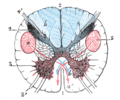Posterior median sulcus of medulla oblongata
(Redirected from Posterior median fissure)
Posterior Median Sulcus of Medulla Oblongata
The posterior median sulcus is a prominent anatomical feature located on the posterior surface of the medulla oblongata, which is the lowermost part of the brainstem. It is a shallow groove that runs along the midline of the medulla oblongata, dividing it into two symmetrical halves.
Anatomy
The medulla oblongata is a vital structure that connects the spinal cord to the brain. It plays a crucial role in controlling various involuntary functions of the body, such as breathing, heart rate, and blood pressure regulation.
The posterior median sulcus is one of the many sulci or grooves present on the surface of the medulla oblongata. It is positioned in the midline, running from the caudal end of the medulla oblongata to its rostral end, where it merges with the fourth ventricle.
The sulcus is relatively shallow compared to other sulci in the brain, but it is still easily identifiable. It is flanked by two raised ridges known as the gracile tubercles, which are more prominent in the caudal part of the medulla oblongata.
Function
The posterior median sulcus does not have a specific functional role on its own. Instead, it serves as a landmark for anatomical orientation and identification of other structures within the medulla oblongata.
The medulla oblongata contains various important structures, including cranial nerve nuclei, ascending and descending tracts, and centers for autonomic functions. The posterior median sulcus helps in locating and distinguishing these structures during anatomical dissections or neuroimaging studies.
Clinical Significance
Although the posterior median sulcus itself does not have any clinical significance, abnormalities or lesions in the surrounding areas of the medulla oblongata can lead to significant neurological symptoms.
For example, damage to the descending tracts located adjacent to the sulcus can result in motor deficits, such as weakness or paralysis of the limbs. Lesions affecting the cranial nerve nuclei in the medulla oblongata can cause various cranial nerve dysfunctions, such as difficulty swallowing or speaking.
Conclusion
The posterior median sulcus of the medulla oblongata is an important anatomical landmark that helps in identifying and locating various structures within this vital part of the brainstem. While it does not have a specific functional role, its presence aids in understanding the complex anatomy and function of the medulla oblongata.
For further information on related topics, you may refer to the following articles:
- Medulla Oblongata: Provides a comprehensive overview of the medulla oblongata and its functions.
- Brainstem: Explores the anatomy and functions of the brainstem as a whole.
- Cranial Nerves: Discusses the twelve pairs of cranial nerves and their functions.
References
1. Standring, S. (Ed.). (2016). Gray's Anatomy: The Anatomical Basis of Clinical Practice (41st ed.). Elsevier.
2. Nolte, J. (2019). The Human Brain: An Introduction to its Functional Anatomy (8th ed.). Elsevier.
Transform your life with W8MD's budget GLP-1 injections from $125.
W8MD offers a medical weight loss program to lose weight in Philadelphia. Our physician-supervised medical weight loss provides:
- Most insurances accepted or discounted self-pay rates. We will obtain insurance prior authorizations if needed.
- Generic GLP1 weight loss injections from $125 for the starting dose.
- Also offer prescription weight loss medications including Phentermine, Qsymia, Diethylpropion, Contrave etc.
NYC weight loss doctor appointments
Start your NYC weight loss journey today at our NYC medical weight loss and Philadelphia medical weight loss clinics.
- Call 718-946-5500 to lose weight in NYC or for medical weight loss in Philadelphia 215-676-2334.
- Tags:NYC medical weight loss, Philadelphia lose weight Zepbound NYC, Budget GLP1 weight loss injections, Wegovy Philadelphia, Wegovy NYC, Philadelphia medical weight loss, Brookly weight loss and Wegovy NYC
|
WikiMD's Wellness Encyclopedia |
| Let Food Be Thy Medicine Medicine Thy Food - Hippocrates |
Medical Disclaimer: WikiMD is not a substitute for professional medical advice. The information on WikiMD is provided as an information resource only, may be incorrect, outdated or misleading, and is not to be used or relied on for any diagnostic or treatment purposes. Please consult your health care provider before making any healthcare decisions or for guidance about a specific medical condition. WikiMD expressly disclaims responsibility, and shall have no liability, for any damages, loss, injury, or liability whatsoever suffered as a result of your reliance on the information contained in this site. By visiting this site you agree to the foregoing terms and conditions, which may from time to time be changed or supplemented by WikiMD. If you do not agree to the foregoing terms and conditions, you should not enter or use this site. See full disclaimer.
Credits:Most images are courtesy of Wikimedia commons, and templates, categories Wikipedia, licensed under CC BY SA or similar.
Translate this page: - East Asian
中文,
日本,
한국어,
South Asian
हिन्दी,
தமிழ்,
తెలుగు,
Urdu,
ಕನ್ನಡ,
Southeast Asian
Indonesian,
Vietnamese,
Thai,
မြန်မာဘာသာ,
বাংলা
European
español,
Deutsch,
français,
Greek,
português do Brasil,
polski,
română,
русский,
Nederlands,
norsk,
svenska,
suomi,
Italian
Middle Eastern & African
عربى,
Turkish,
Persian,
Hebrew,
Afrikaans,
isiZulu,
Kiswahili,
Other
Bulgarian,
Hungarian,
Czech,
Swedish,
മലയാളം,
मराठी,
ਪੰਜਾਬੀ,
ગુજરાતી,
Portuguese,
Ukrainian
Contributors: Prab R. Tumpati, MD



